Introduction
The recurrent, protracted and complex nature of many crises re-enforces the importance of developing longer-term interventions that address humanitarian needs as well as development and peacebuilding challenges. This requires sufficient, flexible and predictable funding. Between 2000 and 2017, 27 countries had more than 5 consecutive years of UN-coordinated appeals. Of these, 16 countries still had UN-coordinated appeals in 2018.
Crisis disproportionately impacts people in poverty. A third of the global population living in extreme poverty (on less than $1.90 per day) are in countries with UN-coordinated appeals in 2018 and consecutively for at least one preceding year. Crisis also has a notable impact on levels of poverty. By the third consecutive year of crisis – in countries with at least five consecutive years of UN-coordinated appeals – populations in extreme poverty were on average 10% larger than poverty projections for these countries had there not been crises.
In 2018, an estimated 206.4 million people living in 81 countries were deemed in need of humanitarian assistance. A large portion of these people continued to be concentrated in a small number of countries: six countries accounted for 80.6 million people in need. As in 2017, Yemen and the Syrian Arab Republic (Syria) had the highest numbers of people in need, 22.2 million and 13.3 million, respectively.
Both conflict and forced displacement in 2018 were prevalent in the crises with the largest populations of people in need. Many countries faced complex crisis situations [1] involving at least two forms of crisis (conflict, disasters associated with natural hazards or forced displacement). Of the 40 countries with the largest populations in need, 23 experienced two or more forms of crisis.
Globally the numbers of forcibly displaced people grew for the seventh consecutive year, to 70.8 million in 2018 (a 3% rise from 2017). For the first time in eight years, the largest numbers of forcibly displaced people were hosted in the South of Sahara region, where the number of internally displaced persons grew by 20%.
The latest comprehensive data on assistance targeted to respond to need shows that the well-established trend of a small number of crises receiving a large proportion of all humanitarian assistance continued in 2017. A total of 10 countries received 63% (or US$11.8 million) of all country-allocable humanitarian assistance.
Poverty and crisis
Figure 1.1: Countries with recurrent crises are home to less than a tenth of the global population, but more than a third of people in extreme poverty
Proportion of global population, of people in poverty and of people in extreme poverty who live in 22 countries with recurrent humanitarian appeals
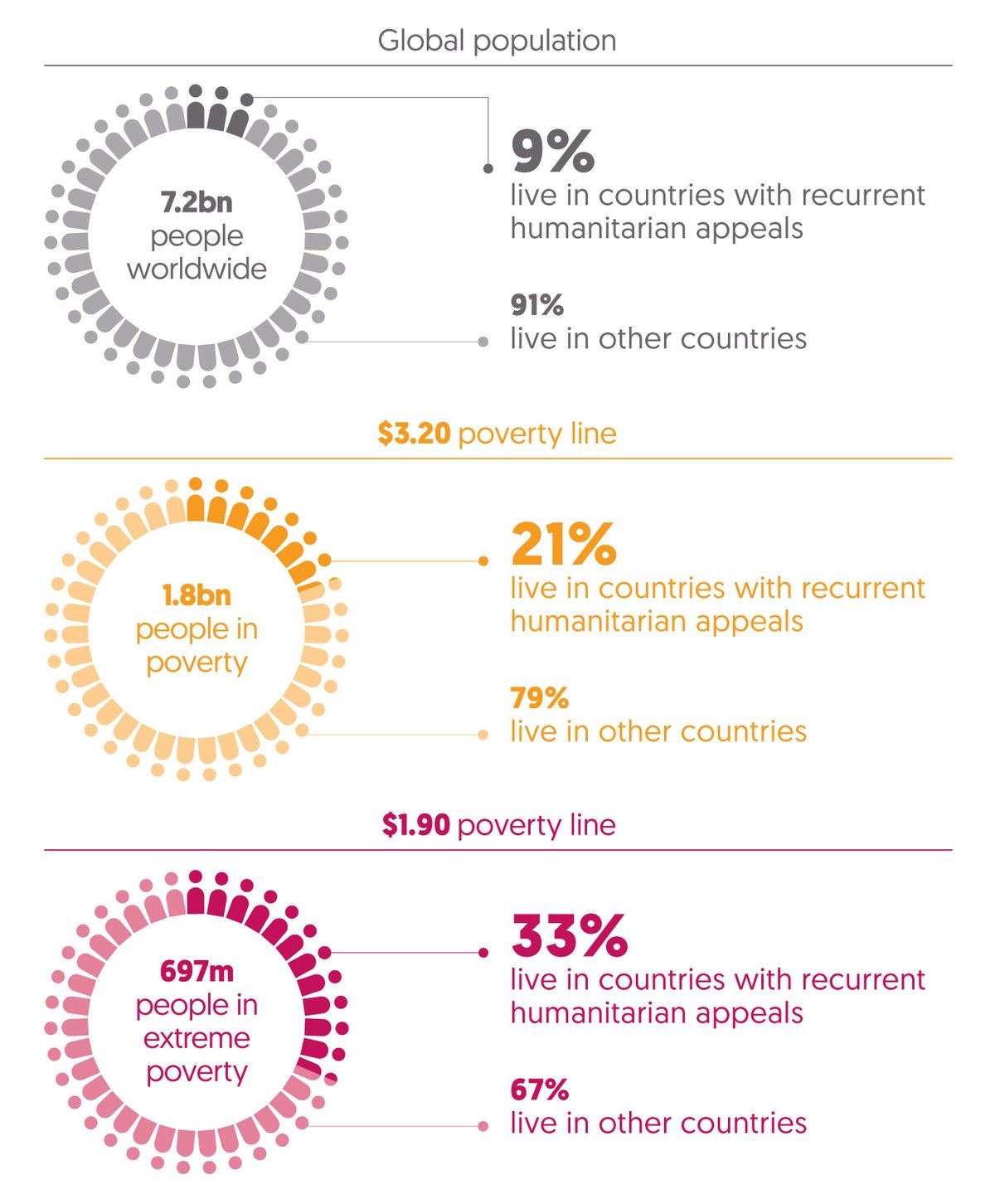
Proportion of global population, of people in poverty and of people in extreme poverty who live in 22 countries with recurrent humanitarian appeals
Source: Development Initiatives based on World Bank PovcalNet, World Development Indicators, International Monetary Fund World Economic Outlook and various national survey sources.
Notes: People living in poverty are defined as living on less than $3.20 a day; people living in extreme poverty are defined as living on less than $1.90 a day. The appeals considered in this analysis are UN-coordinated country response plans.
Crisis can disproportionately impact people in poverty. Limited access to resources among the poorest people can exacerbate vulnerability to crisis, while experiencing crisis can draw people further into poverty. Over time, poverty is expected to become increasingly concentrated in contexts characterised by fragility, conflict, environmental insecurity and protracted crises. This makes the need for a more joined-up approach to development, humanitarian assistance and peacebuilding ever more critical.
Countries with recurrent humanitarian appeals (see Box 1.1) account for a significant share of global poverty.
- The 22 countries with a UN-coordinated appeal in 2018 and consecutively for at least one preceding year are home to 9% of the global population. Yet this group of countries accounts for more than a fifth of the global population in poverty (an estimated 376 million people), defined as living on less than $3.20 a day. [2]
- These countries account for an even higher proportion of the global population living in extreme poverty, defined as surviving on less than $1.90 a day. A third (estimated at 231 million) of people living at or below this international extreme poverty line live in countries with recurrent appeals.
When crises hit, poverty reduces at a slower rate. With more consecutive years of crisis, this impact worsens.
- In countries with at least five consecutive years of UN-coordinated appeals between 2000 and 2017, average rates of poverty reduction fell from 4% of the poor population a year to 0% in the first two years of a crisis.
- By the third consecutive year of crisis – in countries with at least five consecutive years of UN-coordinated appeals – populations in extreme poverty were on average 10% larger than projections of poverty for these countries had there not been crises.
Countries with recurrent humanitarian crises have a disproportionate poverty burden.
- In aggregate, more than a third of the population (35%) of the 22 countries with a UN-coordinated appeal in 2018 and consecutively for at least one preceding year live in extreme poverty (on less than $1.90 a day). This is three times the developing country average of 11.5%.
- Of these 22 countries, 5 have had appeals in at least 10 consecutive years. The average extreme poverty rate across these countries is six times the developing country average, at 64.3% of the population.
- Of the 12 countries worldwide with extreme poverty rates over 50%, 5 have had protracted crisis responses, with five or more consecutive years of appeals since 2000.
Box 1.1
Recurrent and protracted crisis response countries
Development Initiatives has consistently reported that a large number of countries experience crises for multiple years. [3] Countries are now in crisis and in receipt of assistance for longer. This means they need limited resources to be stretched further and responses to be planned, coordinated and implemented over a longer time frame. The current focus on promoting flexible and predictable funding and on effectively delivering collective humanitarian, development and peacebuilding outcomes, in part recognises the need to respond to this altered humanitarian context (see Chapter 3, Figure 3.2, and Chapter 4, Figures 4.5 and 4.6).
In 2018:
- 22 countries were recurrent crisis response countries , meaning that they had UN-coordinated country response plans in 2018 and consecutively for at least one preceding year.
- 27 countries have been protracted crisis response countries between 2000 and 2017, meaning that they had UN-coordinated country response plans for at least 5 consecutive years at some point in this period. [4]
- Of these 27 countries, 16 still had UN-coordinated country response plans in 2018.
Not only are countries regularly in crisis for multiple years, they also frequently suffer from complex crises, experiencing a combination of conflict, forced displacement and/or disasters associated with natural hazards (see Figure 1.2).
Given the prevalence of recurrent and protracted crises, this report looks closely at recurrent and protracted crisis response countries to better understand how international humanitarian assistance and wider financing are being delivered. Throughout, it uses the analysis groupings recurrent crisis response countries and protracted crisis response countries . For the latter grouping, the report looks at either the situation of these countries in 2018 or 2017 (depending on the year for which the most recent data is available) or at their situation during the first five years of each crisis, comparing countries by the year of crisis (rather than by calendar year).
These groupings – focused on the existence of UN-coordinated country response plans [5] – provide a simple and useful, though not comprehensive, proxy for the existence of ongoing and recurrent crisis. Development Initiatives will work to deepen and nuance how it categorises recurrent and protracted crisis response countries for future reports, building on the work of others. [6]
Box 1.2
Poverty data in crisis contexts
There are many well-documented challenges for collecting poverty data in crisis settings. Most poverty data is derived from household income and expenditure surveys. To be useful for understanding poverty, these surveys should be representative of the entire population, but a crisis can undermine this goal.
- Crises can alter survey preparation. Surveys rely on census data to know where populations are, so they know where to send enumerators. However, in crisis settings there may not be a recent census or the data from the latest census may no longer reflect the population. Surveyors must also decide who to include in the survey and frequently exclude displaced persons, nomadic populations, non-citizens and people living in camps. These choices make poverty numbers unrepresentative for key parts of the population.
- Crises frequently disrupt data collection. They can make it impossible to collect data in certain areas or may lead to the loss of records and data. Crises also can distort pricing data at a subnational level making it difficult to compare incomes across the country. Some countries lack any internationally comparable data (such as Afghanistan, the Democratic People’s Republic of Korea, Somalia and Libya). In some countries where there is poverty data, the most recent data predates the crisis onset (such as Yemen and Syria). Survey coverage of conflict-affected states is particularly poor, with no representative survey for over 10 years in half of those countries.
There are several initiatives underway to address these issues. The World Bank, for example, has made a strong commitment to expanding poverty data collection throughout the world – with a focus on certain countries in crisis. One line of research has focused on technology and big data. Satellite imagery, for instance, can provide some data about conditions on the ground. Nonetheless, it cannot provide as rich data as can be collected on the ground and depends on having some data about the population which needs to be collected by other means. Despite some advances, the challenges to gathering poverty data in crisis areas are still significant
People affected by crisis
Figure 1.2: Severe crises are concentrated in sub-Saharan Africa and the Middle East
People in need, type and severity of crisis, and funding requirements, 2018

People in need, type and severity of crisis, and funding requirements, 2018
Source: Development Initiatives based on ACAPS, Food and Agriculture Organization, UN High Commissioner for Refugees (UNHCR), UN Relief and Works Agency for Palestine Refugees in the Near East, Internal Displacement Monitoring Centre (IDMC), INFORM Index for Risk Management, Centre for Research on the Epidemiology of Disasters, Heidelberg Institute for International Conflict Research and UN Office for the Coordination of Humanitarian Affairs (OCHA) Financial Tracking Service (FTS) data.
Notes: CAR: Central African Republic; DPR Korea: Democratic People’s Republic of Korea; DRC: Democratic Republic of the Congo; RRP: regional response plan. Countries selected using ACAPS data and corresponding estimates of people in need. Countries with fewer than an estimated 0.8 million people in need are not shown. For further information on coding crisis types see our online Methodology and definitions.
In 2018, the well-established trend of conflict as a primary driver of large-scale crises continued, as severe violence in Syria, Yemen, Central African Republic (CAR) and the Democratic Republic of the Congo (DRC) resulted in the suffering and widespread displacement of millions of vulnerable people. In Afghanistan, drought and food insecurity, exacerbated by ongoing conflict, saw growing numbers of people in need of humanitarian assistance. Because crisis exacerbates vulnerability and weakens resilience, countries often experience more than one form of crisis (conflict, forced displacement or disasters associated with natural hazards), either from one year to the next or at the same time. In 2018, people in need of humanitarian assistance were widely dispersed geographically, across almost a quarter of all countries, but with high numbers in a small group of countries.
- In 2018, an estimated 206.4 million people living in 81 countries were assessed to be in need of humanitarian assistance.
- There was a high concentration of people in need in just six countries, with more than 10 million people identified in Yemen (22.2 million people in need), Syria (13.3 million), DRC (13.1 million), Turkey (11.1 million), Afghanistan (10.6 million) and the Democratic People’s Republic of Korea (10.3 million). These six countries accounted for 80.6 million people in need, almost two fifths (39%) of the total number.
Population data, particularly in countries in crisis, can be out of date, incomplete and miss those people affected by crisis, in particular refugees and internally displaced persons (IDPs) (see Box 1.2). Notwithstanding these caveats the proportion of a population identified as in need gives an indication of the extent of crisis and need.
- For the six countries with more than 10 million people in need these totals represent the equivalent of more than half their population, with especially high levels of need in Syria (equivalent to 78.7% of the domestic population) and Yemen (77.9%). However, four additional countries also had a high percentage of their population in need: South Sudan (63.8%), CAR (62.1%), the State of Palestine (Palestine) (54.7%) and Lebanon (54.6%).
In 2018, conflict and forced displacement drove the crises impacting the largest populations of people in need. Many countries – particularly those with the largest numbers of people in need – experienced more than one form of crisis (conflict, forced displacement or disasters associated with natural hazards), complicating response, exacerbating need and increasing the duration of crisis situations.
- In 2018, 24 of the 40 countries with the largest populations in need experienced conflict, while 27 experienced forced displacement.
- Meanwhile, 18 of the 40 countries with the largest populations in need experienced disasters.
- Often in 2018, however, countries faced complex crisis situations [7] involving at least two forms of crisis. Of the 40 countries with the largest populations in need, 23 experienced two or more forms of crisis, including six which experienced all three forms of crisis (Afghanistan, Iraq, Sudan, Somalia, Kenya and Libya).
- The impact of complex crisis is pronounced among the 10 countries with the largest populations in need. The combination of conflict and forced displacement affects nine of these countries, where 102.0 million people are in need.
Forced displacement
Figure 1.3: Record numbers of IDPs and refugees mean the seventh consecutive annual increase in forced displacement
20 countries with the largest forcibly displaced populations, 2018
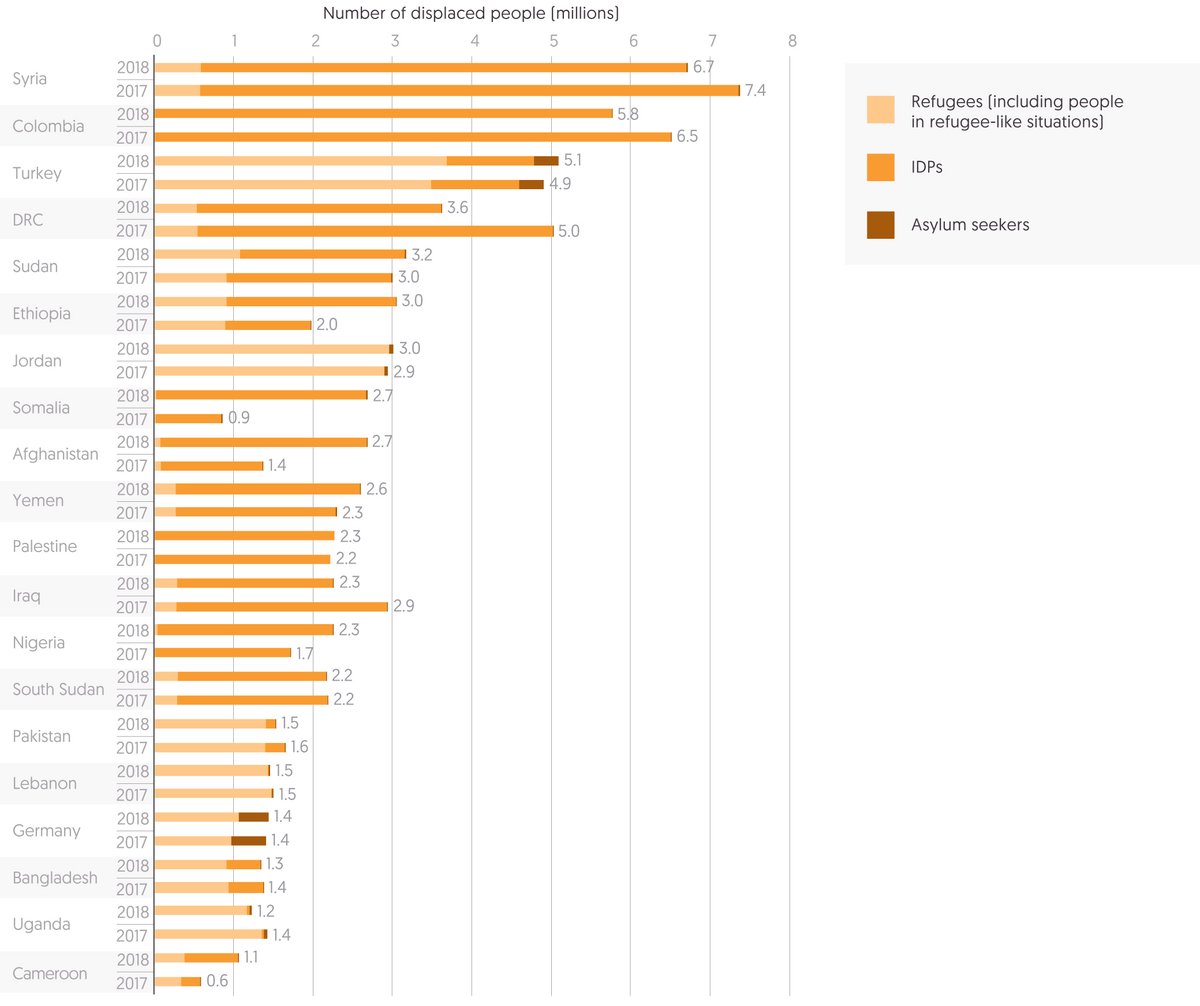
20 countries with the largest forcibly displaced populations, 2018
Source: Development Initiatives based on UNHCR, UN Relief Works Agency for Palestine Refugees in the Near East (UNRWA) and Internal Displacement Monitoring Centre (IDMC) data.
Notes: The 20 countries are selected based on the size of displaced populations that were hosted in 2018. ‘Displaced population’ includes refugees and people in refugee-like situations, internally displaced persons (IDPs) and asylum seekers. IDP figures include a total number of IDPs at the end of 2018 as reported by the IDMC. Data is organised according to UNHCR’s definitions of country/territory of asylum. According to data provided by UNRWA, registered Palestine refugees are included as refugees for Jordan, Lebanon and Syria, and as IDPs for Palestine.
In 2018, the Global Compact on Refugees [8] and the Global Compact for Safe, Orderly and Regular Migration [9] were agreed against a backdrop of conflict, violence and persecution which continued to force growing numbers of people from their homes or prevent their safe return.
- In 2018 the total number of displaced people increased for the seventh consecutive year, to 70.8 million, up from 68.4 million in 2017, an increase of 2.3 million (3%). The numbers of IDPs and refugees both reached record levels in 2018, increasing to 43.6 million and 23.6 million respectively.
In 2018, Turkey hosted the largest number of refugees (3.7 million), as it did in 2017, with the refugee population increasing by 0.2 million from the previous year. Syria continued to be home to the largest number of IDPs – 6.1 million in 2018.
- 10 countries hosted 54% (38.4 million) of the total displaced population in 2018, a slight reduction from 58% in 2017.
- While refugee numbers increased by 1.0 million among these 10 countries, the overall reduction was driven by a fall of 1.9 million in the number of IDPs.
- In 2018, the South of Sahara region, rather than the Middle East and North of Sahara region, hosted the largest number of displaced persons for the first time in eight years, driven by 20% growth in IDPs from 2017.
- From 2009 to 2018, the South of Sahara region has seen the largest rise in the number of displaced persons, up by 10.6 million. Meanwhile, this number grew by 8.9 million in the Middle East and North of Sahara region and by 6.4 million in Europe.
A greater number and proportion of the total displaced population were hosted in low income countries in 2018 than in 2017.
- In 2018, 39% of the total displaced population were in low income countries, compared with 22% in 2017, with 54% in middle income countries compared with 70% in 2017. The proportion in high income countries, 7%, remained unchanged.
- This large proportional shift from middle to low income hosting countries is explained by the impact of ongoing crisis in Syria and Yemen, which has resulted in both countries being reclassified from middle to low income countries.
- Among the ten countries with the largest displaced populations in 2018, Syria and Yemen now sit alongside four other low income countries (DRC, Ethiopia, Somalia and Afghanistan), with the remaining four (Sudan, Colombia, Turkey and Jordan) all being middle income countries.
Figure 1.4: Rising numbers of refugees and asylum seekers from Africa and the Middle East drive new global record
Regions of origin for refugees and asylum seekers, 2009–2018
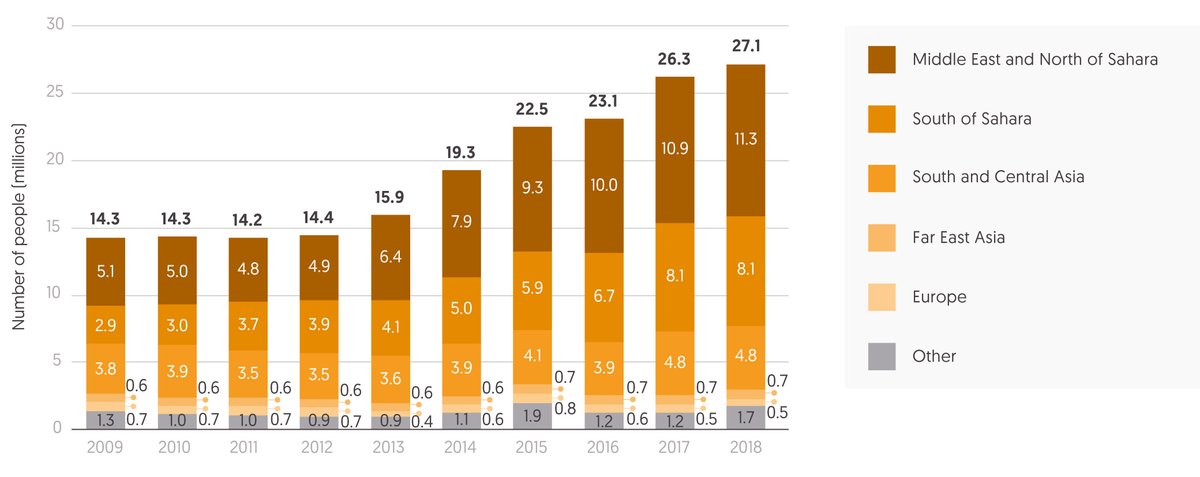
Regions of origin for refugees and asylum seekers, 2009–2018
Source: Development Initiatives based on UNHCR and UN Relief and Works Agency for Palestine Refugees in the Near East.
Notes: Organisation for Economic Co-operation and Development (OECD) country naming has been used for regions, except the Middle East and North of Sahara, which have been combined. ‘Others’ includes the combined total for regions where the number of refugees (including people in refugee-like situations) and asylum seekers was below 600,000 per year: North and Central America, South America, Oceania, stateless people and those with unknown regions of origin.
The total number of refugees and asylum seekers continued to rise in 2018, maintaining the trend seen since 2013, and driven by increases from the Middle East and North of Sahara and South of Sahara regions.
- The total number of refugees and asylum seekers globally rose to 27.1 million in 2018, almost double the level in 2012 (14.4 million).
- The number of refugees and asylum seekers originating from the Middle East and North of Sahara over this period increased by 6.5 million (51% of the total growth) and from the South of Sahara region by 4.3 million (33%).
- The largest number of refugees and asylum seekers originated from the Middle East and North of Sahara – 42% of the total (11.3 million) in 2018. Syria accounted for just under two thirds (60%, 6.8 million) of these refugees and asylum seekers Despite the large-scale protracted crisis in Yemen only 1% (67,046) of the region’s total came from this country.
Figure 1.5: Countries bordering crisis countries bear disproportionate burden of hosting refugees and asylum seekers
20 largest countries of origin for refugees and asylum seekers by bordering and non-bordering hosting countries, 2018
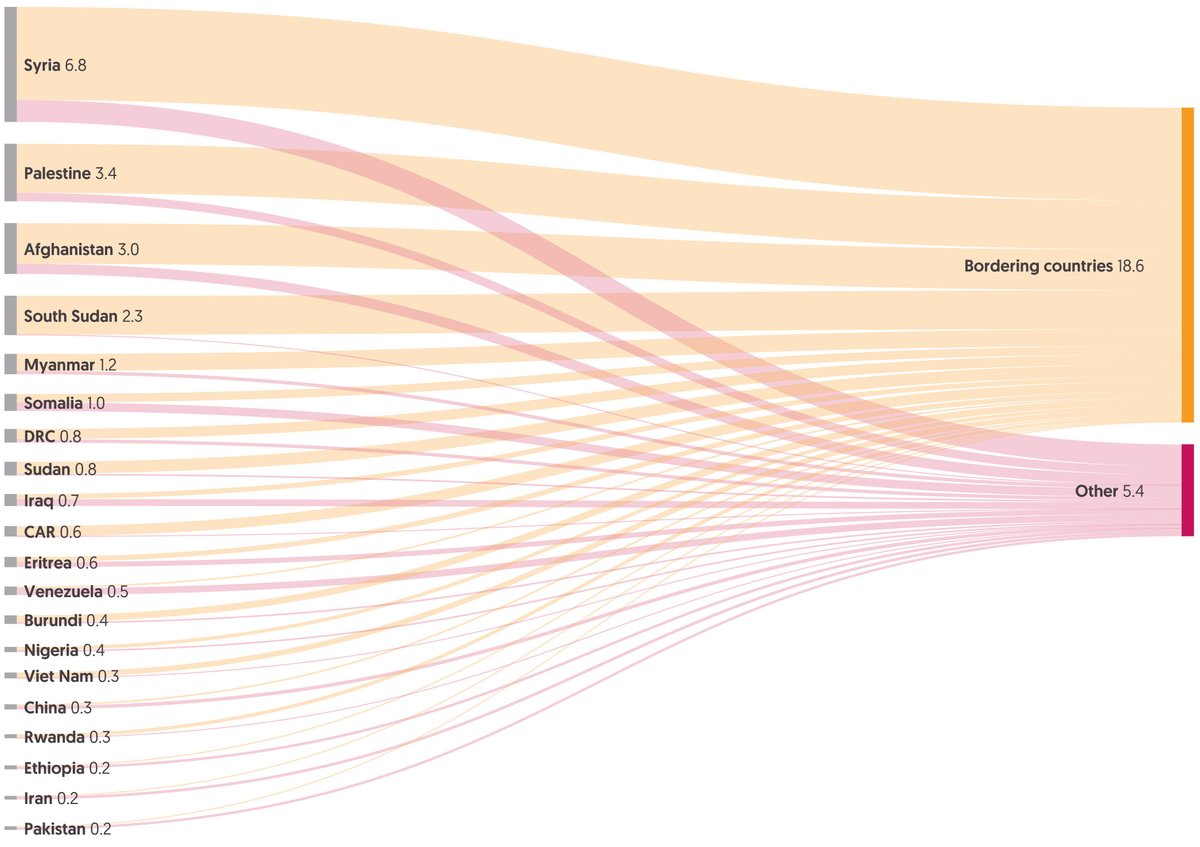
20 largest countries of origin for refugees and asylum seekers by bordering and non-bordering hosting countries, 2018
Source: Development Initiatives based on UNHCR, UN Relief and Works Agency for Palestine Refugees in the Near East (UNRWA) and World Factbook CIA data.
Notes: CAR: Central African Republic. The 20 origin countries are selected based on the number of refugee and asylum seekers in 2018. Data is organised by UNHCR’s definitions of country/territory of asylum and origin country. UNRWA data includes Palestine refugees as refugees for Jordan, Lebanon and Syria. Bordering countries are countries that share a geographical border with a particular country. The numbers in this chart exclude other displaced populations of concern to UNHCR: for Venezuela and Afghanistan in 2018, this included 2,592,947 and 489,859 people respectively.
In 2018, 24.0 million refugees and asylum seekers originated from 20 countries, accounting for 88% of the total number of externally displaced persons. Figure 1.5 shows these 20 countries and whether refugees and asylum seekers move to countries directly bordering their country of origin. Countries neighbouring those in crisis receive the majority of refugees and asylum seekers, bearing the most significant burden for their support. They are very rarely rich, high income countries with the greatest resources to cope.
- Of the 24.0 million refugees and asylum seekers from the 20 selected countries, 18.6 million (78%) were displaced to bordering countries.
- Among the four largest countries of origin, most refugees and asylum seekers moved to bordering countries; this is most markedly the case for South Sudan, accounting for 99% of its refugees and asylum seekers leaving the country.
- Most refugees and asylum seekers (75%, 14 million) who moved to bordering countries went to middle income countries. The remaining 25% (4.6 million) were hosted in low income countries, with hardly any refugees and asylum seekers moving to high income countries (694).
Where refugees and asylum seekers move beyond those countries immediately bordering their country of origin, the pattern changes, with over half moving to high income countries.
- Of the 24.0 million refugees and asylum seekers from the 20 selected countries, 5.4 million (22%) went to non-bordering countries.
- Of these 5.4 million refugees and asylum seekers, 57% (3.0 million) moved to high income countries, while 35% (1.9 million) moved to middle income countries and 8% (0.5 million) to low income countries.
- Among the four largest countries of origin, above-average proportions (76% and 67% respectively) of refugees and asylum seekers relocated from Syria and Afghanistan to non-bordering high income countries (as already noted, only 1% of South Sudan’s refugee population moved to non-bordering countries). However, just 4% relocated to non-bordering high income countries from Palestine.
Targeting of crisis financing
Figure 1.6: Assistance continues to concentrate in a small number of crises
10 largest recipients of international humanitarian assistance, 2017
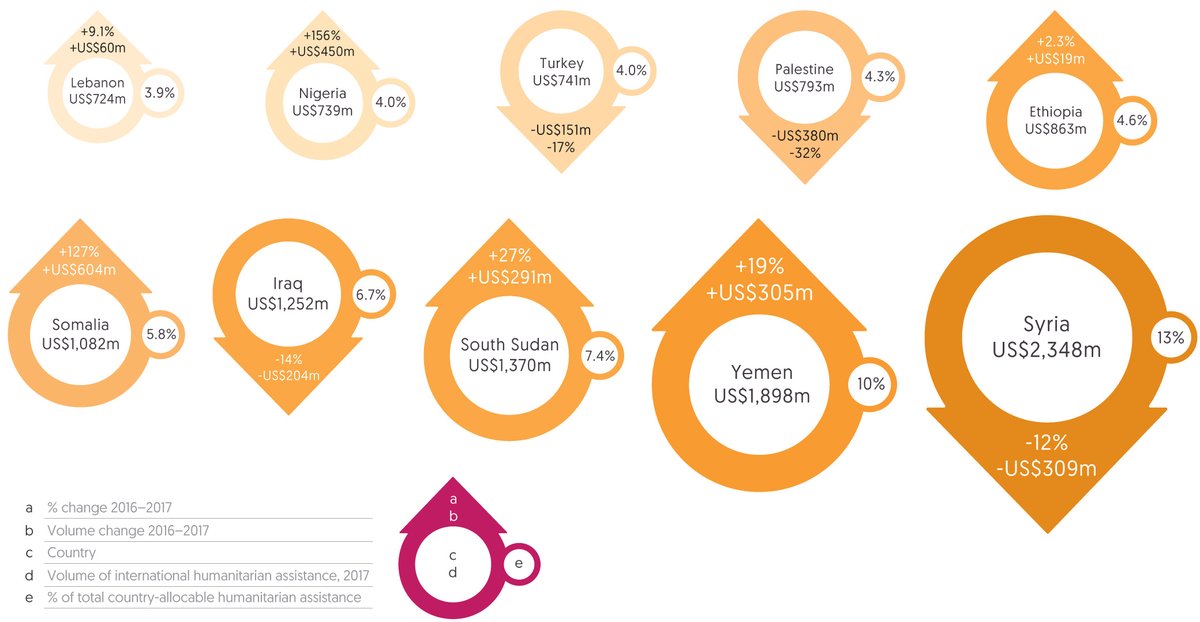
10 largest recipients of international humanitarian assistance, 2017
Source: Development Initiatives based on OECD Development Assistance Committee (DAC), UN OCHA FTS and UN Central Emergency Response Fund (CERF) data.
Notes: Data is in constant 2017 prices.
Large numbers of crises now endure for many years, requiring greater levels of resources and over a longer period of time (see Box 1.1 and Chapter 2, Figure 2.2). There are growing numbers of people in need, including record numbers of forcibly displaced people. The volume of international humanitarian assistance has increased year-on-year in response to this growing need (see Chapter 2, Figure 2.1).
The latest comprehensive data from Organisation for Economic Co-operation and Development (OECD) Development Assistance Committee (DAC) sources on where assistance has been targeted in response to need is for 2017. This data indicates that the well-established trend of a small number of crises receiving a large proportion of all humanitarian assistance has remained unchanged. However, there were notable rises and falls in volumes of assistance among the group of largest recipients.
- In 2017, 10 countries accounted for 63% (or US$11.8 million) of all country-allocable humanitarian assistance. This proportion has remained between 59% and 66% for eight years of the preceding decade to 2008.
- Seven of these ten countries had recurrent UN-coordinated country response plans in 2017. The remaining three countries, Lebanon, Turkey and Ethiopia, had received funding through regional refugee response plans for at least two of the immediately preceding years. [10]
- Syria was the largest recipient of international humanitarian assistance for the sixth consecutive year, despite a 12% fall in funding received from 2016.
- Large increases in funding to Somalia (up 127%) and Nigeria (up 156%) meant they became the fifth and ninth largest recipients, respectively, in 2017, having not featured among the ten largest in 2016.
- Yemen and South Sudan also received large increases in international humanitarian assistance in 2017, with contributions growing by 19% and 27% respectively.
- Funding to Palestine, however, fell by almost a third (32%) in 2017, having risen by a similar proportion (30%) in 2016. This represented the greatest decrease among the 10 largest recipients, proportionally and by volume (falling US$380 million), and was largely driven by a reduction in funding from the US of US$323 million.
- Five of the ten largest recipients were low income countries (Syria, Yemen, South Sudan, Somalia and Ethiopia), two were lower middle income countries (Nigeria and Palestine) and three were upper middle income countries (Iraq, Turkey and Lebanon).
Figure 1.7: Trend of increasing assistance to middle income countries halted as Syria and Yemen become low income countries
20 largest recipients of international humanitarian assistance by income group, 2008–2017
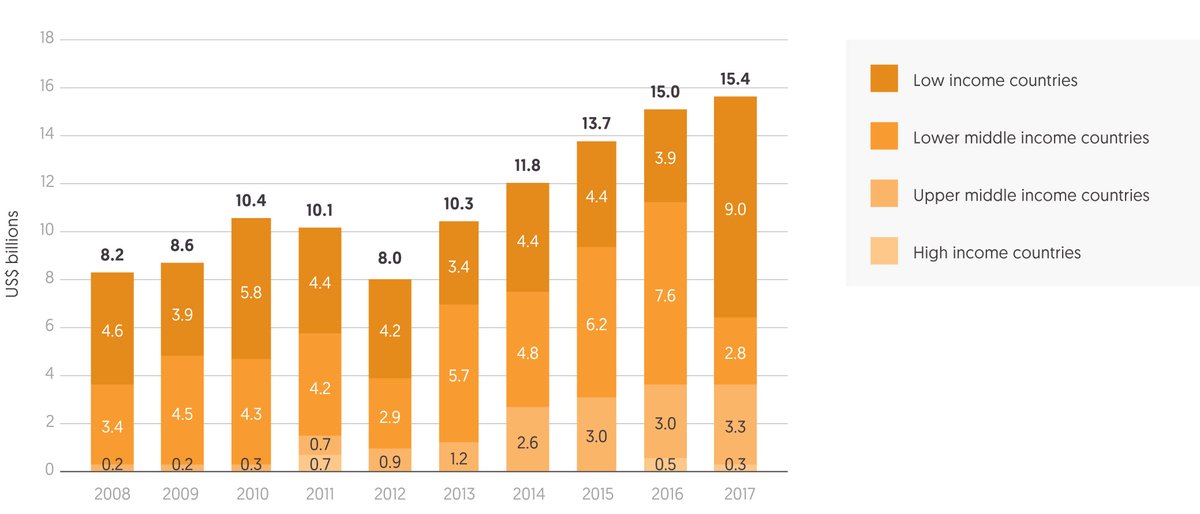
20 largest recipients of international humanitarian assistance by income group, 2008–2017
Source: Development Initiatives based on OECD DAC, UN OCHA FTS, UN Central Emergency Response Fund (CERF) and World Bank data.
Notes: The countries’ income groups are according to the classification of World Bank income groups for any given year. Income groups therefore might change year on year for the same recipient. The largest 20 recipients of international humanitarian assistance are also for each given year and hence vary year on year. Data is in constant 2017 prices.
Figure 1.7 illustrates the distribution of international humanitarian assistance by income group for the 20 countries receiving the largest volumes of assistance. The ongoing crises in Syria and Yemen since 2012 have resulted in more international humanitarian assistance being directed to upper middle income countries. In 2017, the impact of protracted crisis in Syria and Yemen and the resultant deterioration and reclassification of their economies has contributed to a sharp rise in funding to low income countries.
- The proportion of assistance going to upper middle income countries has risen from 2% in 2008 to 22% in 2017, with proportions rising steadily from 2011 as increasing volumes of funding were channelled to Jordan, Lebanon and Turkey to respond to the Syria crisis.
- This increase in funding among the 20 largest recipients to upper middle income countries in part explains the steadily reducing proportion flowing to low income countries between 2012 and 2016, falling from 52% to 26%, having averaged 56% in the preceding decade.
The channelling of funding to respond to the crises in Syria and Yemen has also driven the trend for more assistance being directed to countries with higher incomes. Yet income group data for these largest recipients of humanitarian assistance also illustrates the domestic impact of protracted crisis in these two countries.
- Syria and Yemen have both been recategorised from lower middle income countries to low income countries. This recategorisation is behind the sharp increase in assistance to low income countries in 2017, up US$5.1 billion, and decrease to lower middle income countries, down US$4.8 billion.
*The notes for Figure 1.5 were clarified in April 2020.
Downloads
Notes
-
1
The UN defines a complex crisis as “a humanitarian crisis in a country, region or society where there is a total or considerable breakdown of authority resulting from internal or external conflict and which requires an international response that goes beyond the mandate or capacity of any single and/or ongoing UN country program.” See: https://interagencystandingcommittee.org/system/files/legacy_files/WG16_4.pdf . For the analysis, ‘complex crises’ refer to those that simultaneously involve at least two of the three types – disasters associated with natural hazards, forced displacement situations or conflict.Return to source text
-
2
This figure is in PPP (purchasing power parity) to allow for comparison of poverty data across countries. PPPs are constructed by comparing the cost of a common basket of goods in different countries. To reflect internationally comparable poverty lines, we use the $1.90 and $3.20 poverty lines derived from 2011 prices.Return to source text
-
3
For example, see Figure 1.6, Development Initiatives, 2018. Global Humanitarian Assistance Report 2018. Available at: http://devinit.org/wp-content/uploads/2018/06/GHA-Report-2018.pdfReturn to source text
-
4
Crises can improve or worsen year on year, while external attention and commitments of assistance also vary. Of the 34 countries with a UN-coordinated appeal in 2018, 12 had received appeal funding for 8 of the last 10 years.Return to source text
-
5
This includes humanitarian response plans, flash appeals and other UN-coordinated country response plans that are humanitarian – or humanitarian related, such as humanitarian strategic plans or joint response plans.Return to source text